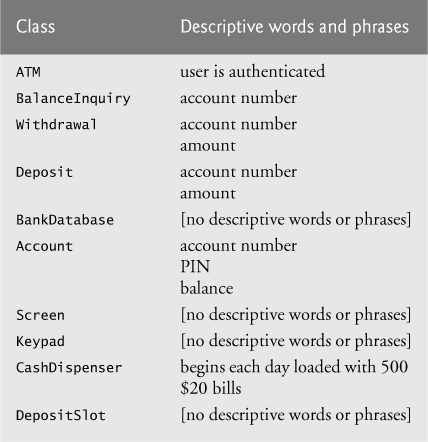Identifying Attributes
Consider the attributes of some real-world objects: A person’s attributes include height, weight and whether the person is left-handed, right-handed or ambidextrous. A radio’s attributes include its station setting, its volume setting and its AM or FM setting. A car’s attributes include its speedometer and odometer readings, the amount of gas in its tank and what gear it’s in. A personal computer’s attributes include its manufacturer (e.g., Dell, HP, Apple or IBM), type of screen (e.g., LCD or CRT), main memory size and hard disk size.
We can identify many attributes of the classes in our system by looking for descriptive words and phrases in the requirements document. For each one we find that plays a significant role in the ATM system, we create an attribute and assign it to one or more of the classes identified in Section 22.4. We also create attributes to represent any additional data that a class may need, as such needs become apparent throughout the design process.
Figure 22.11 lists the words or phrases from the requirements document that describe each class. We formed this list by reading the requirements document and identifying any words or phrases that refer to characteristics of the classes in the system. For example, the requirements document describes the steps taken to obtain a “withdrawal amount,” so we list “amount” next to class Withdrawal.
Fig. 22.11. Descriptive words and phrases from the ATM requirements.
Figure 22.11 leads us to create one attribute of class ATM. Class ATM maintains information about the state of the ATM. The phrase “user is authenticated” describes a state of the ATM (we introduce states in Section 22.6), so we include userAuthenticated as a Boolean attribute (i.e., an attribute that has a value of either true or false). The UML Boolean type is equivalent to the bool type in C++. This attribute indicates whether the ATM has successfully authenticated the current user—userAuthenticated must be true for the system to allow the user to perform transactions and access account information. This attribute helps ensure the security of the data in the system.
Classes BalanceInquiry, Withdrawal and Deposit share one attribute. Each transaction involves an “account number” that corresponds to the account of the user making the transaction. We assign an integer attribute accountNumber to each transaction class to identify the account to which an object of the class applies.
Descriptive words and phrases in the requirements document also suggest some differences in the attributes required by each transaction class. The requirements document indicates that to withdraw cash or deposit funds, users must enter a specific “amount” of money to be withdrawn or deposited, respectively. Thus, we assign to classes Withdrawal and Deposit an attribute amount to store the value supplied by the user. The amounts of money related to a withdrawal and a deposit are defining characteristics of these transactions that the system requires for them to take place. Class BalanceInquiry, however, needs no additional data to perform its task—it requires only an account number to indicate the account whose balance should be retrieved.
Class Account has several attributes. The requirements document states that each bank account has an “account number” and “PIN,” which the system uses for identifying accounts and authenticating users. We assign to class Account two integer attributes: accountNumber and pin. The requirements document also specifies that an account maintains a “balance” of the amount of money in the account and that money the user deposits does not become available for a withdrawal until the bank verifies the amount of cash in the deposit envelope, and any checks in the envelope clear. An account must still record the amount of money that a user deposits, however. Therefore, we decide that an account should represent a balance using two attributes of UML type Double: availableBalance and totalBalance. Attribute availableBalance tracks the amount of money that a user can withdraw from the account. Attribute totalBalance refers to the total amount of money that the user has “on deposit” (i.e., the amount of money available, plus the amount waiting to be verified or cleared). For example, suppose an ATM user deposits $50.00 into an empty account. The totalBalance attribute would increase to $50.00 to record the deposit, but the availableBalance would remain at $0. [Note: We assume that the bank updates the availableBalance attribute of an Account soon after the ATM transaction occurs, in response to confirming that $50 worth of cash or checks was found in the deposit envelope. We assume that this update occurs through a transaction that a bank employee performs using some piece of bank software other than the ATM. Thus, we do not discuss this transaction in our case study.]
Class CashDispenser has one attribute. The requirements document states that the cash dispenser “begins each day loaded with 500 $20 bills.” The cash dispenser must keep track of the number of bills it contains to determine whether enough cash is on hand to satisfy withdrawal requests. We assign to class CashDispenser an integer attribute count, which is initially set to 500.
For real problems in industry, there is no guarantee that requirements specifications will be rich enough and precise enough for the object-oriented systems designer to determine all the attributes or even all the classes. The need for additional (or fewer) classes, attributes and behaviors may become clear as the design process proceeds. As we progress through this case study, we too will continue to add, modify and delete information about the classes in our system.

